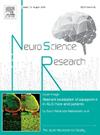多次连续应激大鼠肌内辣椒素致脊髓伤害性超敏反应。
IF 2.4
4区 医学
Q3 NEUROSCIENCES
引用次数: 0
摘要
持续的生理和心理应激与慢性肌肉疼痛的发展高度相关;然而,应激性痛觉过敏的神经机制在很大程度上仍然未知。本研究旨在阐明应激性肌肉痛觉过敏的外周和脊柱机制,采用多次连续应激(MCS)大鼠模型,将大鼠置于1.5cm深的浅水笼中饲养5或6天。在MCS大鼠中,肌肉注射辣椒素(300μM, 50μL),激活trpv1阳性肌肉c纤维伤害感受器,增加疼痛相关的面部表情评分(采用大鼠鬼脸量表)。与naïve对照大鼠相比,肌内注射辣椒素可诱导MCS暴露大鼠同侧脊髓背角(I-VI椎板)L3-L5节段显著的c-Fos表达。MCS组对侧c-Fos表达增加。使用离体肌肉神经制剂的单纤维电生理记录显示,在MCS组中,肌肉c -纤维的一般特征和对有害刺激的反应都没有改变。这些结果表明脊髓伤害性超敏反应与MCS引起的肌肉疼痛有关。然而,它不太可能是通过改变对肌肉c纤维伤害感受器的反应来介导的。本文章由计算机程序翻译,如有差异,请以英文原文为准。
Spinal nociceptive hypersensitivity induced by intramuscular capsaicin in rats subjected to multiple continuous stress
Persistent physical and psychological stress is highly relevant to the development of chronic muscle pain; however, the neural mechanisms underlying stress-induced hyperalgesia remain largely unknown. This study aimed to elucidate the peripheral and spinal mechanisms of stress-induced muscle hyperalgesia using a rat model developed under multiple continuous stress (MCS) by keeping rats in a cage filled with shallow water (1.5 cm in depth) for 5 or 6 days. In the MCS rats, intramuscular injection of capsaicin (300 μM, 50 μL), which activates TRPV1-positive muscular C-fiber nociceptors, increased pain-related facial expressions scored using a rat grimace scale. Intramuscular capsaicin injections induced significant c-Fos expression throughout the ipsilateral spinal dorsal horn (laminae I–VI) at segments L3–L5 in rats exposed to MCS, when compared to naïve control rats. Increased c-Fos expression was also observed on the contralateral side in the MCS group. Single-fiber electrophysiological recordings using ex vivo muscle-nerve preparations revealed that neither the general characteristics nor the responsiveness of muscular C-fibers to noxious stimuli were altered in the MCS group. These results indicate that spinal nociceptive hypersensitivity is associated with muscle pain induced by MCS. However, it is unlikely to be mediated by altered responses to muscular C-fiber nociceptors.
求助全文
通过发布文献求助,成功后即可免费获取论文全文。
去求助
来源期刊

Neuroscience Research
医学-神经科学
CiteScore
5.60
自引率
3.40%
发文量
136
审稿时长
28 days
期刊介绍:
The international journal publishing original full-length research articles, short communications, technical notes, and reviews on all aspects of neuroscience
Neuroscience Research is an international journal for high quality articles in all branches of neuroscience, from the molecular to the behavioral levels. The journal is published in collaboration with the Japan Neuroscience Society and is open to all contributors in the world.
 求助内容:
求助内容: 应助结果提醒方式:
应助结果提醒方式:


